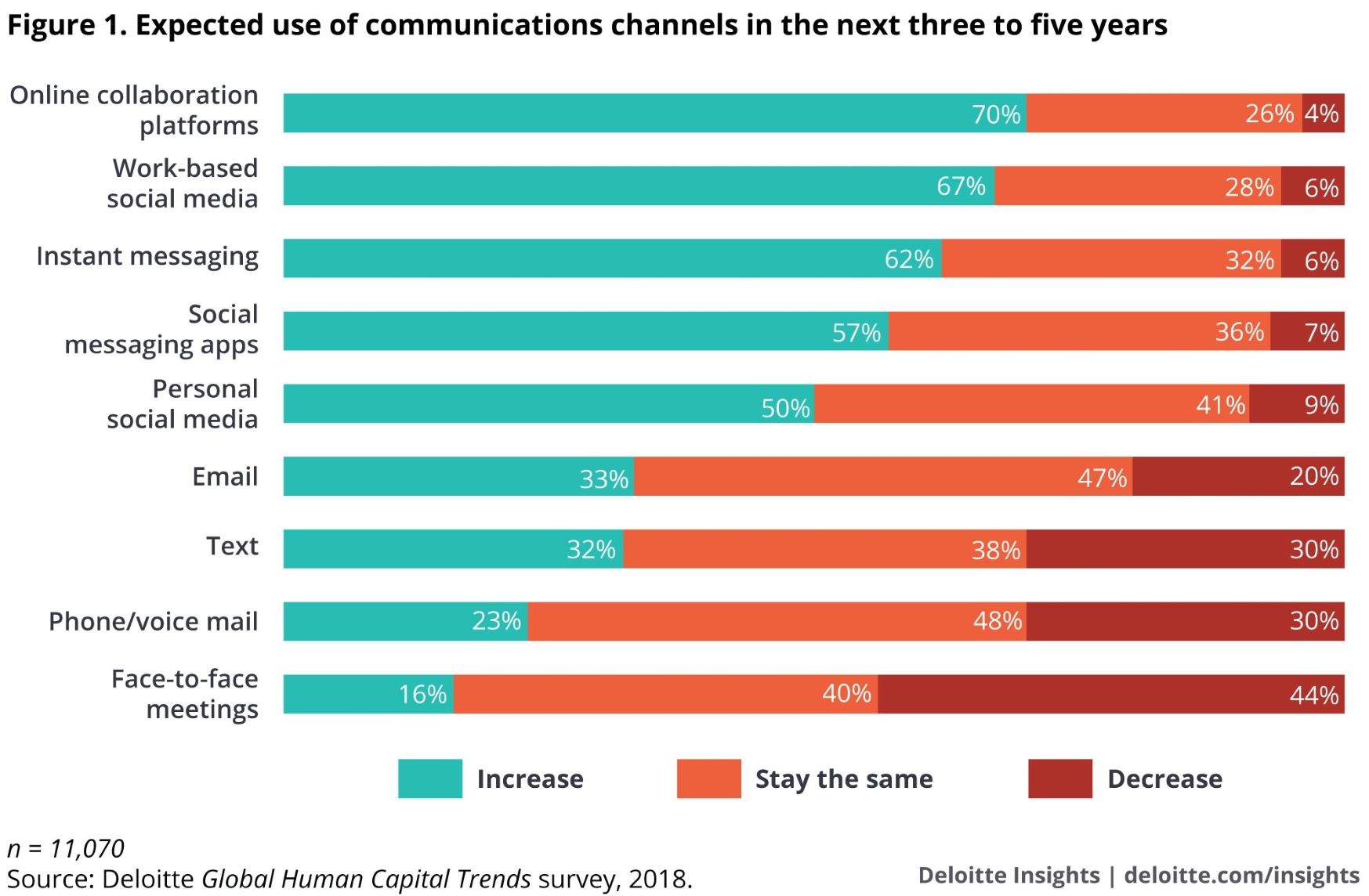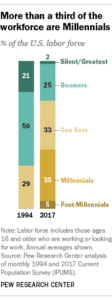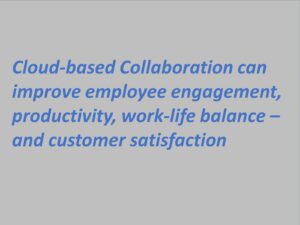I assure you, this isn’t one of those painful ‘When I was your age…’ lectures your father might unleash about ‘…how hard life was back in MY day.’ (Although much to my consternation, I still haven’t identified his school route that was uphill BOTH ways.) But to be sure, so much in this world has undergone significant change in the last generation, and the workplace is certainly no exception.
As we sit well in the 21st Century, workplace dynamics have shifted towards connecting office headquarters to multiple satellite/home locations, employees with non-traditional hours, and more mobile and remote workspaces. And increasingly, these dynamics are requiring real-time connectivity on a multitude of devices – computer workstations, laptops, phones, and tablets.

Move over traditional workplaces…Millennials are in town
The arrival of Millennials (generally defined as ages 22-37 in 2018) into the workforce certainly has hastened these movements to collaborative workplaces. No matter the industry, the ‘silos’ that were prevalent in years past are morphing towards a more desegregated work philosophy based on collaboration – featuring a stronger reliance on ‘teams’ where many are involved in identifying objectives, setting strategy, and doing the work. From this standpoint, the substantial progress in technology in the last 15 years is serving as a perfectly-timed springboard to further Millennials’ workplace values.
Millennials are also driving a shift from the more traditional (read: constrained) working rules to more flexible ones – where they do their work, when they do it, and how they do it. A statistic that further underscores Millennials’ desire for collaboration: according to a June 2018 worldwide market study by leading research and advisory company Gartner, a larger proportion of Millennials (26%) consider the collaborative applications they use in their personal lives (social media, etc.) to be more useful than those they are given at work; only 10% of Baby Boomers said the same. As demand has increased for workplace usage of apps that have historically been considered ‘personal,’ developers have discussed the merits of a ‘professional’ version of these applications for use in places of business.
 Despite the Boomer generation holding onto their jobs longer (according to the U.S. Census Bureau’s Current Population Survey 1963-2016), Millennials still have more bodies than any other generation in the U.S. workforce. Millennials became the largest generation in the labor force in 2016, and by 2017 were leading all gens with 35% of the total workforce (Pew Research Center).
Despite the Boomer generation holding onto their jobs longer (according to the U.S. Census Bureau’s Current Population Survey 1963-2016), Millennials still have more bodies than any other generation in the U.S. workforce. Millennials became the largest generation in the labor force in 2016, and by 2017 were leading all gens with 35% of the total workforce (Pew Research Center).
Put all these learnings together, and it’s easy to see this as one of the main catalysts behind the move towards a cloud-based collaborative working environment.
Collaboration: the bridge from today’s to tomorrow’s workplace
According to the Gartner survey, an organization with high ‘digital dexterity’ has employees with the cognitive ability and social practice to leverage and manipulate media, information and technology in unique and highly innovative ways. Not surprisingly (by virtue of them having grown up with the technology), younger employees tend to be the most inclined to take advantage of workplace digital resources – including video/telepresence, voice/conferencing, messaging, and interactive meetings and workspaces. They generally have a positive attitude towards technology in the workplace, combined with a greater affinity for working in alternative-office situations.
“Solutions targeting new ways of work are tapping into a high-growth area,” said Craig Roth, research vice president at Gartner.
As more forward-thinking businesses choose to embrace mobile, team-based and alternative-routine ways of working, many of them are finding there is much work to be done to make their workplace technology truly agile. According to the Gartner survey, fewer than 20% of enterprises currently possess the ‘digital dexterity’ to adopt Collaboration solutions – including unassigned workspaces, virtual collaboration (a result of increased telecommuting), and flex time. And as employee attitudes continue to aspire toward Collaboration, it has become evident that forcing workers to accept strict and inflexible traditional workplace mandates is a surefire formula for poor employee performance. And if enough employees fit this category, a company’s health can suffer.

Workplace Evolution: to change or not to change?
We’ve already seen how few organizations are in a place to adopt Collaborative work philosophies right now. Thus far, larger companies tend to have a higher immediate adoption of workplace collaboration – mainly due to more readily available resources to commit to the endeavor.
“Embracing dynamic work styles, devices, work locations and team structures can transform a business and its relationship to its staff. But digital dexterity doesn’t come cheap,” said Gartner’s Roth. “It takes investment in workplace design, mobile devices and software, and larger organizations find it easier to make this investment.”
Two things are for certain: in the coming years, as the most exceptional, ‘blue-chip’ employees either enter the workforce or move around with within it, their preferred occupational environments will almost assuredly involve a collaborative, flexible, non-traditional work situation. And businesses that make it a point to postpone, partially adopt, or ignore this seismic shift altogether will lose out on attracting (and retaining) top talent.
Cloud-based Collaboration can improve employee engagement, productivity, work-life balance – and customer satisfaction

As we’ve noted in this blog, a truly collaborative workspace boasts many moving parts, encompassing all that video, voice, messaging and meeting technology has to offer. Imagine the challenges of keeping all of those parts on-site, in working order, and getting them to perform both accurately and timely.
Now imagine these resources all residing in ONE central place – the cloud.
From an IT standpoint, allowing these tools to be cloud-based simplifies the solution considerably, freeing your on-site IT staff from the responsibility of using unproductive time to get the resources to work as they should. (Please raise your hand if you’ve spent 5+ minutes at the start of a meeting waiting for the technology to start working. You may put your hand down now.)

Employee efficiency stands to grow as well. Consider the vast amounts of unproductive time workers waste traveling to off-site meetings (locally or out of town), poring through endless emails (which often can consume the better part of a day, and usually culminating in very little actual productivity), and struggling to track down key decision-makers to advance a project. Add to that the money spent on travel, lodging, meals, etc.
Cloud-based collaboration can help workers improve upon all these issues. Employees can communicate more efficiently, advance their work more effectively – and because of the realized efficiencies, lead to a happier and more engaged workforce.
Global intelligence firm IDC, which recently surveyed over 800 mid-sized organizations about their workplace strategy, found companies who used cloud-based collaboration initiatives saw a +47% improvement in speed-to-market for products and services, a +42% improvement in customer satisfaction and loyalty, and a -34% reduction in costs.
“Digital natives may completely disrupt an industry, but companies need to look at this as an opportunity to conduct business and engage customers in new ways,” said Mark Winther, group VP of telecom custom solutions at IDC. “Our data clearly shows that cloud communications enable businesses to quickly adapt and transform and, as a result, not only survive but actually thrive in their respective industries.”
How do I get started?
How can businesses start leveraging Collaboration tools to transform workplace productivity? A sound business improvement strategy involves:
- Instill Collaboration technologies (voice/video conferencing, messaging, interactive work spaces) within existing business procedures
- Identify the Collaborative activities that drive results
- Allow your workforce to use these behaviors as an accepted part of the job
- Set specific targets and use analytics to measure outcomes
- Optimize accordingly to improve challenged areas
- Incentivize behaviors for business results as necessary
Still some bugs to work out
Despite the myriad of Collaboration benefits, the system is not yet perfect. According to some organizations who have gone Collaborative, there was disconnect in instances where employees did not take advantage of all allotted resources (for example, headsets that could make for a smoother collaborative experience). Another challenge, especially in a cloud-based collaborative environment, is that companies lose a certain amount of control over communications infrastructure, leading them to rely on the performance of their technology suppliers on top of an internet connection. If your technology provider has a bad day, the collaboration has a bad day. However, given the advancements cloud technology has made in the last several years combined with the business benefits more than make up for the loss of control.
Conclusion
Today’s workforce has changed considerably in the past decade. More businesses are hiring remote employees and freelance workers, and supplementing with more part-time staff to overcome an escalating scope of work. As these changes get more commonplace, increased collaboration to get the work done is critical…and technology advancements are paving that road for us. Innovative Collaboration techniques can boost an organization’s productivity by as much as 30%. As retail and B-to-B customers continue to push for an enhanced experience, quicker response times and a greater value equation, companies are compelled to use available technology to improve Collaboration to meet these demands. And with it, employees get the sense of heightened value at work that they’ve been looking for.
Find out more about how TEC Communications (a Cisco Premier Certified partner) can activate its Collaboration solutions to help empower your mobile and remote staff to work seamlessly together at

